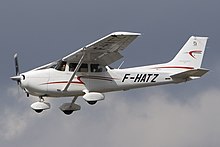Tractor configuration
This article needs additional citations for verification. (October 2011) |


In
In the early years of powered aviation both tractor and pusher designs were common. However, by the midpoint of the First World War, interest in pushers declined and the tractor configuration dominated. Today, propeller-driven aircraft are assumed to be tractors unless it is stated otherwise.[citation needed]
Origins
The first airplane to have a "tractor" configuration was the
World War I military aviation
The downside of a single-engine tractor aircraft was that it was initially impossible to fire a gun through the propeller arc without striking the propeller blades. Early solutions included mounting guns (rifles or machine guns) to fire around the propeller arc, either at an angle to the side – which made aiming difficult – or on the top wing of a biplane so that the bullets passed over the propeller arc.[citation needed]
The first system to fire through the propeller was developed by French engineer
A more workable solution was a gun synchronizer, which utilized a synchronization gear developed by aircraft pioneer Anthony Fokker and fitted to the Fokker E.I monoplane in 1915. The first British "tractor" to be specifically designed to be fitted with synchronization gear was the Sopwith 1½ Strutter which did not enter service until early 1916.[citation needed]
Other solutions to avoiding the propeller arc include passing the gun's barrel through the propeller's hub or spinner – first used in production military aircraft with the World War I French
References
- ^ Mario Calderara, Commander Calderara Glances Backward and Ahead, U.S. Air Services, Volume 15, Air Service Publishing Company, September 1930, page 38
- ^ "Calderara, Mario in Dizionario Biografico". www.treccani.it.
- ^ "Propellers and tractor-screws" Correspondence Flight 23 April 1910.
